Harmony Korine: ‘Jordi Mollà and I communicated for a year just with photos of iguanas doing their business’
The filmmaker just released ‘AGGRO DR1FT’, an experimental film shot using thermal cameras, which caused the audience to run away at its premiere in Venice
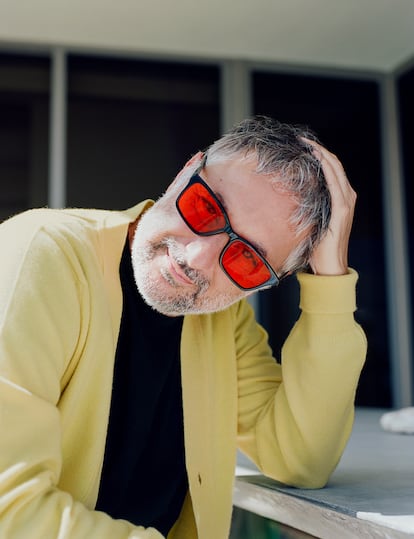
Harmony Korine, 50, has lost interest in traditional filmmaking. From his home in Miami, the California-born filmmaker shares his enthusiasm for what he perceives as new energy beyond what we considered films. In fact, his latest project, AGGRO DR1FT, is more than a movie. “I’m not sure I can call it that. Actually, I don’t know what exactly it is yet,” he says via video call.
This visual artifact, which premiered out of competition at the most recent Venice Film Festival, has made a splash. It is about a hitman seeking revenge in an apocalyptic Miami, but the plot is the least of it. Filmed with NASA thermal cameras and starring Jordi Mollà and rapper Travis Scott, AGGRO DR1FT navigates between the world of video games, anime and the real-digital image of Disney’s adaptations of its animated classics. This is all supported by sophisticated post-production work done with artificial intelligence that achieves powerful abstract images. It’s like immersing oneself in a psychedelic version of a Grand Theft Auto video game.

Korine sees the work as an attempt to explore what comes after the movies, as well as a response to the confusion he believes the entertainment industry is experiencing with regard to AI: “I understand artificial intelligence as a creative tool, like a paintbrush or a color. Right now, I don’t see an existential threat, but I’m not saying there isn’t one, " he says, in a veiled reference to the concerns that AI has caused among various art sectors. AGGRO DR1FT also represents the first preview of EDGLRD, a mini-studio composed of video game developers, programmers, skaters, hackers and musicians. Perhaps it is an alternative streaming platform amid platform capitalism?
“Creatives need a new channel to develop instinctively, where they can create content without a linear distribution. They don’t need to rely on a system that no longer works and doesn’t make anyone happy,” he says. Entertainment, attention economy and turbo-capitalism. Initial reactions to the proposal have been mixed, with part of the audience leaving the room in horror and another part applauding for 10 minutes at the end: for many, it is the return of a visionary; for others, there are serious doubts about the authenticity of this whole enterprise.
Since his breakthrough in the mid-1990s with the Kids (1995) screenplay, Harmony Korine has challenged the limits of narratives and the conventions of that amorphous thing called independent cinema. He is interested in the marginalized, the antiheroes who fight for their space, for their small utopia even if that comes through destruction. Gummo, his 1997 directorial debut, was built from ruins: it was a disjointed montage of unconnected vignettes that anticipated the fragmentation and speed with which we currently relate to images thanks to the internet. His ugly depiction of teenagers in a rural Nashville town devastated by a hurricane led to an iconic image that today could be a viral TikTok video: Jacob Reynolds eating spaghetti in a bathtub.
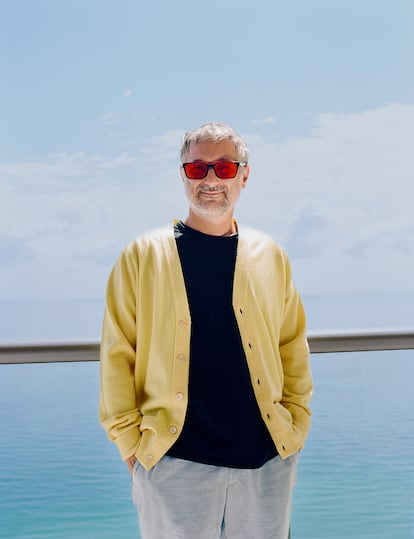
Gummo successfully blended the findings of Jonas Mekas’s film diary, Alan Clarke’s misfits, MTV, skate videos and the slapstick comedy of The Three Stooges. It was a tender and not at all paternalistic look at the grotesqueness of the United States at the turn of the millennium, like that of a contemporary troubadour. In part, that had to do with his girlfriend at the time, actress Chloë Sevigny, who, in addition to acting, was in charge of the now legendary costume design. Gummo’s impact earned him Jean-Luc Godard’s self-professed admiration.
Korine’s next feature film, Julien-Donkey Boy (1999), delved into an increasingly rarefied atmosphere that anticipated the rough textures of much of the video art and avant-garde cinema that was to come in the new century. The filmmaker drew on Lars von Trier and Thomas Vinterberg’s controversial Dogma 95 movement and bent many of its rules. Korine’s ability to capture the zeitgeist, energy and aesthetics of the moment went hand in hand with an increasingly self-destructive attitude. Someone even said that, in his television appearances, he looked like Charlie Chaplin on acid.
At that time, he left one of his most unclassifiable projects, Fight Harm, unfinished. The film consisted of shouting at strangers in the street to start a fight as two cameras recorded it. The rules were simple: the person chosen had to be physically bigger than Korine and he always had to get the first punch in. “I think my films are either comedies or horror. Or both. I had W.C. Fields in mind and that kind of gag where someone slips on a banana. I wanted to push the genre to the limit, but it got out of hand, and I ended up in a terrible way. It was a very dark time.”
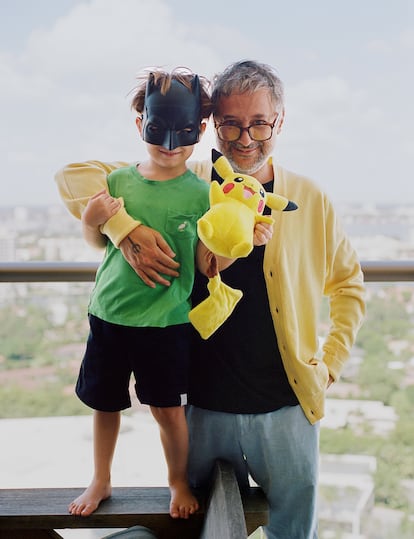
Hitting rock bottom almost made Korine abandon cinema. But in 2007, revived by his friends, his brother, the filmmaker Werner Herzog and French gallery owner Agnès B., he gave us what is probably his most misunderstood work, which is also his most visually clear film: Mister Lonely. It is the story of a Michael Jackson impersonator searching for his true identity—a luminous, more or less classic narrative, which was unusual of Korine to that point. “Hardly anyone saw it. I think it’s a miracle that it exists. But you know what? It has some stunning images, like the nuns on bicycles flying through the air. That scene might be the most beautiful thing I’ve ever shot.”
Trash Humpers (2009) put Korine back in that unclassifiable place where he seems to feel most comfortable. With no plot-nude-denouement, it replicated the sensation of finding a VHS tape in the trash and discovering the recordings of three masked men dedicated to wandering around a suburb and smashing everything. Challenging conventional distribution through the Warp Records music label, it had a secondhand videotape edition with the cover created by Korine himself and another one limited to five units on 35 mm celluloid: a full-fledged troll job. His rough photography preceded the fetishism for analog texture that has become popular in recent years, especially in advertising, a world with which Korine is familiar. His work for fashion brands like Gucci and Proenza Schouler and his music videos for pop stars have kept him afloat. “It’s a pretty complicated format. I hate most music videos. Some I’ve done, like the one for Rihanna (”Needed Me,” 2016), I like, but in general I hate them. I think it’s because the singers want to see themselves singing the lyrics. And you also have to look after the image of the star—it’s boring!”
Then came Spring Breakers (2012), the antithesis of boredom. The film is an unbeatable summary of the aesthetics of the ‘10s: an orgy of neon lights, Skrillex music, Britney Spears, bikinis, MTV (yes, again) and pink ski masks, sublimating the Magaluf organized by American college students every spring in Florida. The preview in Madrid, Spain, was attended by the director and the stars, Disney superstars Selena Gomez and Vanessa Hudgens, along with Rachel Korine, Harmony’s current wife, in an event hosted by Raquel Sánchez Silva. It was practically an expanded cinematic experience. “I struggled to get Spring Breakers off the ground. I wanted a fluid, frenetic narrative. It was an experiment where I applied some techniques from my advertising work. And it worked! Now, in hindsight, I see how much it has influenced popular culture.”
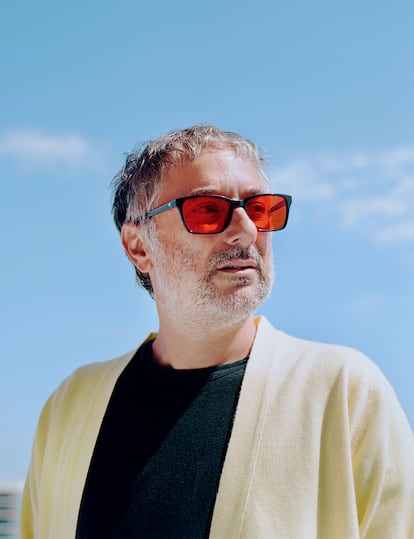
If everything is Harmony Korine, then nothing is Harmony Korine. In The Beach Bum (2018), his penultimate film, a wacky musical comedy starring a histrionic poet and alter ego played by Matthew McConaughey, one sensed that, in the middle of the decade of personal branding, Korine had decided to reconcile with his personality. If in Gummo the main characters drowned a cat in a barrel at the very beginning, The Beach Bum opens with McConaughey hugging and cuddling a sweet white kitten.
Today, promoting his new reinvention, the director and father of two appears comfortable as the line between artist and content creator seems increasingly blurred. “It’s very difficult to decipher what’s happening now. We are in a moment that we could call post-meaning. My partner at EDGLRD, Matt Holt [editor of The Paris Review], and I talk a lot about how video games, anime and animation, even the way we consume music, are evolving, " he says. He describes the confusing accelerationism and crazed image consumption of our time: “It’s gone beyond the linear entertainment we were used to. I’ve always been interested in creating images that go beyond any explanation; that’s why this moment is very exciting for me. I feel that, for the first time, technology is getting closer to dreams [and] that because of it, we can go directly from brain waves to images and graphics.”
That analogical way of understanding such processes also influenced how he found Jordi Mollà and decided to offer him the lead role in AGGRO DR1FT. “Jordi charmed me in Bad Boys II and Blow. His looks, his voice, his charisma.... It turned out he lived three doors down from me in Miami. Someone gave him my phone number, and, via WhatsApp, he started sending me pictures of iguanas doing their business on my terrace. I decided to get on my jet ski and take pictures of the iguanas pooping on his terrace as well. For a year, we had a conversation that was basically just through pictures of iguanas. When I finally met him in person, I loved him instantly.”
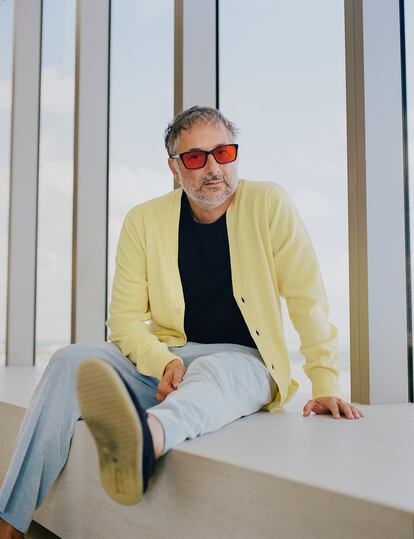
AGGRO DR1FT is situated at an intermediate point, in a glitch, between the obsolescence of cinema as we understood it and doubt about whether there is excitement about how video games are transforming the way we tell stories. Mollà's unflappable voiceover and many of the dialogues are constantly repeated, as if they were non-playable characters (NPCs) wandering in a twilight atmosphere, partly thanks to an impressive sound design supported by the Araabmuzik-composed soundtrack, which is responsible for many of the film’s discoveries.
“We are witnessing the last gasp of what was and, at the same time, the birth of something new from its ashes. I grew up with cinema. I’ve watched and made movies since I was a teenager. I love them. I mean [to say] that maybe there is something new on the horizon.” In reality, AGGRO DR1FT gives the impression of being less groundbreaking and avant-garde than it aspires to be. Its careful and ultra-violent images, in which “violence almost acts like a dance that extends throughout the film,” show a respect for a certain tradition within experimental cinema. In its punk, lysergic and very Generation X way, AGGRO DR1FT joins the recent reflections of Martin Scorsese and Victor Erice on contemporary cinema, eschewing nostalgia and seeking an ally in the immense flow of digital images and in the gamification of reality.
In addition to receiving the Leopard of Honor for his entire career at the Locarno festival last August, Korine just opened an exhibit of oil paintings for Hauser and Wirth in Los Angeles. They are based on stills from AGGRO DR1FT, a show that serves as a teaser for the film in which he plays with the concept of immersive exhibition. “Painting is another form of entertainment. Painting is a solitary process between the artist and the canvas, but in the end, when people go to a museum or gallery, they want to be entertained.” Despite the apparent cynicism that statement may imply, there is still hope for moviegoers willing to be surprised: “I still believe in poetry. I’ll still be in the movies. Terrence Malick has written a beautiful script and wants me to direct it. I would love to do it. He’s one of my heroes.”
Sign up for our weekly newsletter to get more English-language news coverage from EL PAÍS USA Edition
Tu suscripción se está usando en otro dispositivo
¿Quieres añadir otro usuario a tu suscripción?
Si continúas leyendo en este dispositivo, no se podrá leer en el otro.
FlechaTu suscripción se está usando en otro dispositivo y solo puedes acceder a EL PAÍS desde un dispositivo a la vez.
Si quieres compartir tu cuenta, cambia tu suscripción a la modalidad Premium, así podrás añadir otro usuario. Cada uno accederá con su propia cuenta de email, lo que os permitirá personalizar vuestra experiencia en EL PAÍS.
¿Tienes una suscripción de empresa? Accede aquí para contratar más cuentas.
En el caso de no saber quién está usando tu cuenta, te recomendamos cambiar tu contraseña aquí.
Si decides continuar compartiendo tu cuenta, este mensaje se mostrará en tu dispositivo y en el de la otra persona que está usando tu cuenta de forma indefinida, afectando a tu experiencia de lectura. Puedes consultar aquí los términos y condiciones de la suscripción digital.
More information
Archived In
Últimas noticias
Welcome to the post-religion era: The idea of Christianity as the absolute truth has become obsolete
‘I thought you would like it’: The risky sexual practice popularized by TV shows and TikTok
The digitalization of tourism: ‘They promise experiences and gave us the worst possible one’
Mexican peso defies uncertainty with forecasts of a new period of stability in 2026
Most viewed
- Sinaloa Cartel war is taking its toll on Los Chapitos
- Oona Chaplin: ‘I told James Cameron that I was living in a treehouse and starting a permaculture project with a friend’
- Reinhard Genzel, Nobel laureate in physics: ‘One-minute videos will never give you the truth’
- Why the price of coffee has skyrocketed: from Brazilian plantations to specialty coffee houses
- Silver prices are going crazy: This is what’s fueling the rally










































